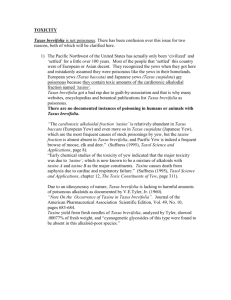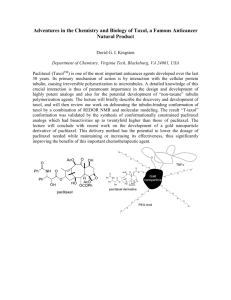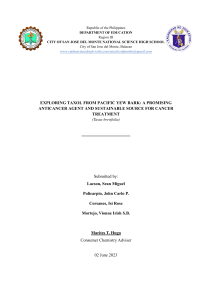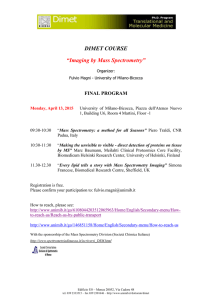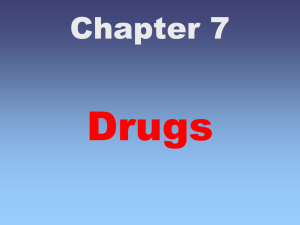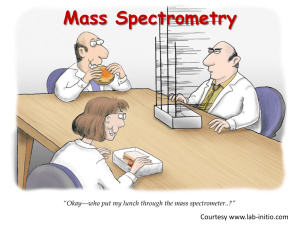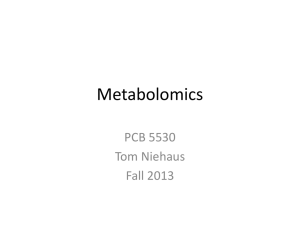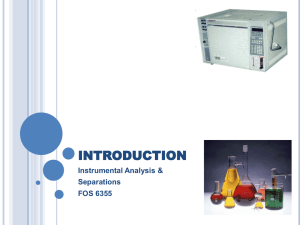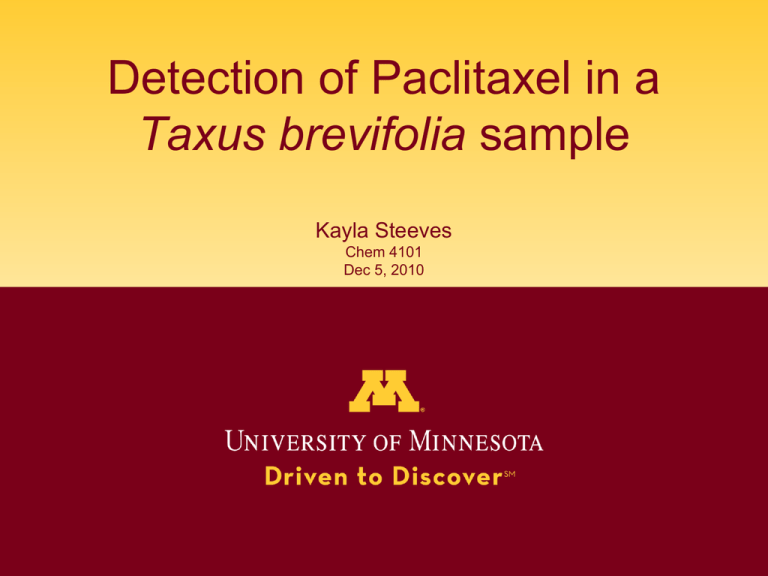
Detection of Paclitaxel in a
Taxus brevifolia sample
Kayla Steeves
Chem 4101
Dec 5, 2010
What is Paclitaxel?
[10]
• Paclitaxel is a natural product originally
isolated from the bark of the tree Taxus
brevifolia.
• Paclitaxel is a chemotherapeutic agent,
and is used to treat advanced cancer of
the ovaries, breast, lung, and Kaposi
sarcoma.
• Taxus brevifolia is native to the pacific
northwest region of North America
• Hypothesis-A compound analogous to
the diterpenoid paclitaxel, will be isolated
from a sample collected from Taxus
brevifolia.
Significance- As a valuable anti-cancer
drug, It should be established quantitatively
how much Pacitaxel can be isolated from
the root of the Taxus brevifolia.
This information can then be used to
determine if other methods of production
should be explored.
Appropriate Technique: Liquid
Chromatography/Mass Spectrometry/Mass
spectrometry[6,7,8,9]
• Suitable for complex plant matrices
• Provides molecular mass, structural, and relative
concentrations information
• Suitable for samples of limited quantities
• Taxane database containing characteristic
chromatographic and mass spectrometric data assessable
• LC columns specific for taxane analysis
• Direct sample introduction
Instrumentation
[6,7]
• Varian 1200L LC/MS/MS (used $69,900)
• Liquid Chromatography
•
•
•
•
•
Curosil-PFP, 5 μm, 150 × 4.6 mm, column ($645)
Flow rate-1mL/min
Gradient elution-Acetonitrile/Water (25:75) to Acetonitrile/Water (65:35)
40 Minutes
20°C
• Tandem Mass Spectrometry
•
•
•
•
Triple Quadrupole
Electrospray ionization, operated at a 350°C and 5500 V
Multiple-reaction monitoring mode- enhance the selectivity and specificity of low
content compounds in Taxus species
Full-scan spectra acquired over the m/z range of 10–1000 amu, step size 0.1
amu and dwell time of 1.5 s.
Sample Preparation
Step 1:
•Ground with a mortar
•Extract with 25 mL methanol, sonicate for 1 hour, sit over
night 20°C
Step 2:
•Vacuum filter, dispose of plant residue
•Dry solution with rotary evaporator
Step 3:
•In separatory funnel combine with 100 mL ethyl acetate
and 100 mL water
•Dry out ethyl acetate fraction with rotary evaporator
MeOH
Fraction
Step 4:
•In separatory funnel combine with 90 mL methanol, 90
mL hexane, and 20 mL water
•Retain aqueous solution, dry using rotary evaporator
• Dilute in methanol, centrifuge,collect supernatant for
analysis
Dried root
sample
MeOH
Extract
EtoAc
Fraction
Water
Fraction
(dispose)
Hexane
Fraction(disp
ose)
Figures of Merit
[6]
•
•
•
•
•
•
•
High selectivity
High sensitivity
Good reproducibility
LOD 8 ng/mL
LOQ 26 ng/mL
Linearity range 0.060-38.8 μg/mL
Correlation factor (R2) 0.9937
• Ma-mass
Data Analysis
[6]
Using the external standard method, perform
linear regression, construct a calibration curve
Generate curve from 8 concentrations of
standards
Three replica injections of each concentration
standard, use average value for the peak area
values
Following HPLC separation, measure the peak
area corresponding to the transition of m/z
854.4→ 286.1, retention time 31.56 minutes
Peak areas obtained from the MRM used to
quantify
Sample Spectrum
LC-MS Mass Chromatogram[6]
Mass Spectrum[7]
Alternative Methods
Method
Advantages
Disadvantages
Ultraviolet-Visible
Absorption[3,8]
Inexpensive, all organic
Does not detect all
samples suitable, low LOD taxanes
Infrared Spectroscopy[8]
Quick, some structural
information, FTIR possess
high accuracy and
precision
Micellar Electrokinetic
Chromotography[8,10]
Superior resolution,
Developed for low
neutral compounds,
molecular mass
complex matrices allowed, compounds
quick, chiral separation
capabilities
Gas
Chromatography/Mass
Spectrometry[8]
Quick, ideal technique for Limited to volatile species
separating and identifying
species in mixtures, longer
columns
Many functional groups
present in paclitaxel
Conclusions
•
•
•
•
•
•
LC/MS/MS allows for sensitivity, precise, and repeatable quantitative
analysis of Taxus brevifolia samples.
Multiple-reaction monitoring mode helpful for optimizing sensitivity and
accuracy.
Curosil-PFP, 5 μm, 150 × 4.6 mm, column, selective and optimum for
this study.
Quadrupoles are great for MS/MS. Despite the presence of a poor
vacuum quadrupoles can funtion, since the ions are produced under
atmospheric pressure conditions; this makes them well suited to
electrospray ionization. Quadrupole mass spectrometers have a
relatively low cost which also makes them attractive as electrospray
analyzer.
Future studies could be completed on the sap produced by the Taxus
brevifolia.
Further studies could also be explored for other trees in the Taxus
genus.
References
1
Auriola O.K.; Lepisto M.A.; Naaranlahti T. Determination of Taxol by High-Performance Liquid
Chromatography-Thermospray Mass Spectrometry. Journal of Chromatography. 1992, 594, 153158.
2
Bhat, S.V.; Nagasampagi, B.A.; Sivakumar, M. Chemistry of Natural Products; Springer: India,
2005.
3
Bitsch, F.; Wenwen, M.; Macdonald, F; Nieder M.; Analysis of Taxol and Related Diterpenoids
From Cell Cultures by Liquid Chromatography-Electrospray Mass Spectrometry. Journal of
Chromatography. 1993, 615, 273-280.
4
Gross, H.J. Mass Spectrometry, Springer-Verlag: Germany, 2004.
5
Hanson R. James, Natural Products the Secondary Metabolites. The Royal Society of Chemistry,
2003.
6
Kerns, H. E.; Volk, J.K.; Hill, E. S.; Profiling Taxanes in Taxus Extracts Using LC/MS and
LC/MS/MS Techniques. Jounral of Natural Products. Voi.57, No. I0,pp. 1391-1403, 1994.
7
Li, Shuangming.; Fu, Yujie.; Yuangang, Zu.; Determination of Paclitaxel and Other six Taxoids in
Taxus Species by High-Performance Liquid Chromatography–Tandem Mass Spectrometry.
Journal of Pharmaceutical and Biomedical Analysis 49. 2009. 81–89
8
Skoog, Douglas A., F. James Holler, and Stanley R. Crouch. Principles of Instrumental Analysis.
Thomson Brooks/Cole. 2007. 6th Ed.
9
Steven L. Richheimer, David M. Tinnermeier, Daniel W. Timmons. High-Performance Liquid
Chromatographic Assay of Taxol. Anal. Chem., 1992, 64 (20), pp 2323–2326.
10 Suffness, M. Taxol Science and Applications. CRC press: Boca Raton. 1995.

